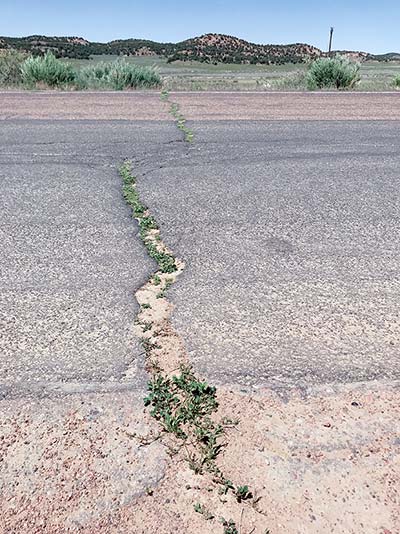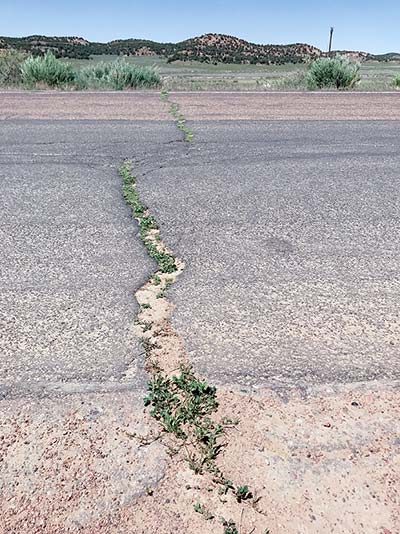
Looking toward the sunset

Navajo Times / Cindy Yurth Weeds grow through cracks in Navajo Route 41 Monday. Forest Lake Chapter is hoping to obtain funds through the Office of Navajo and Hopi Indian Relocation to repair the road.
Tribe gearing up for closure of U.S. Office of Navajo and Hopi Indian Relocation
FOREST LAKE, Ariz.

Navajo Times / Cindy Yurth
Weeds grow through cracks in Navajo Route 41 Monday. Forest Lake Chapter is hoping to obtain funds through the Office of Navajo and Hopi Indian Relocation to repair the road.
When the Navajo-Hopi Relocation Plan was finalized in 1981, the feds predicted it would take five years to move all the Navajos off the Hopi Partitioned Land and vice versa.
At the end of 2016, 35 years later, there were still 74 families left to move and 119 appeals pending for denied claims.
Meanwhile, some of those who were successfully relocated are complaining their government-built houses are falling apart or were never hooked up to electricity.
The communities impacted by relocation (and the coal mining that necessitated it) say they were never compensated for the increased pressure on their infrastructure and public buildings.
With Washington talking once again about sunsetting the Office of Navajo and Hopi Indian Relocation, the federal office that administers the funds, the Navajo Nation is scrambling to assess the extent of ONHIR’s unfinished business.
It is also asking the 17 impacted chapters — White Cone, Teesto, Tolani Lake, Shonto, Coalmine Canyon, Tonalea, Tuba City, Forest Lake, Piñon, Black Mesa, Chilchinbeto, Hard Rock, Whippoorwill, Low Mountain, Jeddito, Blue Gap/Tachee and Nahata Dziil — for help.
“We’re asking community members to bring documentation” in the form of contracts, photographs of cracked foundations, etc., said Michelle Crank, public information officer for the Navajo Nation president’s office, at a public meeting on the matter here Monday. “What really makes an impact is if you write it down on paper.”
The Navajo-Hopi Land Commission — the tribal office assigned to deal with relocation issues — and the president’s office are also asking chapter leadership to fill out a questionnaire asking about the number of relocatees in their chapter as well as the state of housing, roads, community facilities, communications and economic development — all areas that were impacted by relocation and may be used to squeeze one last round of funding out of the feds before ONHIR bites the dust.
“These areas are the things that the people said they were promised,” explained Wenona Benally, executive director of the land commission. “We’re trying to figure out, How much does Congress need to provide?”
While everyone agrees the need is practically limitless, former Navajo-Hopi Land Commission office director Roman Bitsuie, who acted as translator for the meeting, cautioned attendees to be prepared to back up their figures and set priorities.
“We need a reasonable cost, reasonable estimate,” he said, especially in the current budget-slashing political climate, or Congress could conceivably toss the funding part of the sunset legislation altogether.
Explained Benally, “They’re going to ask, ‘Where are you going to put it (buildings or infrastructure)? Did you do your feasibility study yet? How much is it going to cost to run the water line through here?’
“It could make it a much easier request if your could have your plan ready,” she said.
With the data the commission gathers at these meetings (two had already been held at Hard Rock and Coalmine Canyon, and two more are scheduled July 10 in Jeddito and Aug. 14 in White Cone), the office can put together a proposal that the president and Council can use to lobby Congress for a fair settlement to close out the relocation effort, Bitsuie explained.
To read the full article, pick up your copy of the Navajo Times at your nearest newsstand Thursday mornings!
Are you a digital subscriber? Read the most recent three weeks of stories by logging in to your online account.








 Highway 264,
Highway 264, I-40, WB @ Winslow
I-40, WB @ Winslow